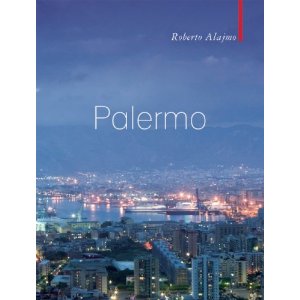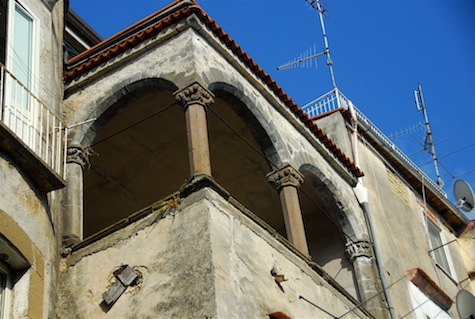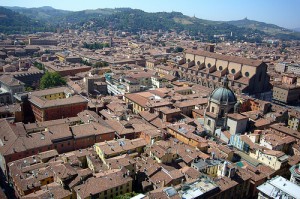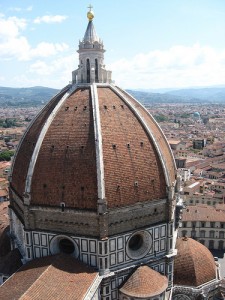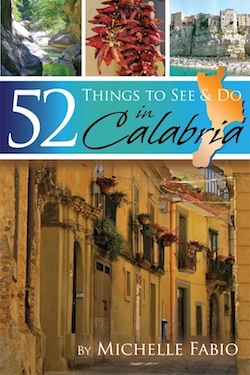Archive for 2010
Gita Italiana 2010: When I Was Two, I Was Nearly New
 Today’s stop on the Gita Italiana comes to us via Kate Bailward of Driving Like a Maniac; this post was originally published on Kate’s blog earlier this summer.
Today’s stop on the Gita Italiana comes to us via Kate Bailward of Driving Like a Maniac; this post was originally published on Kate’s blog earlier this summer.
Welcome Kate!
*
‘… la bimba?‘ I look up. There’s a two year old in a pink bikini standing in front of me with an enquiring look on her face. I realise too late that she was asking me a question. I have absolutely no idea what the question was, but it seems she wants an answer. I’m stumped. I settle for saying ‘si‘ with a bit of an upward inflection and hoping that it will head her off at the pass. Nope. She repeats again, and again all I catch is ‘la bimba.’ Is she asking where my daughter is? I look confuddled. She tries another tack. ‘Dov’è il tuo amico?‘ Well, actually he’s administering an exam for my PON students in Scorrano today, but I have no idea how to say that in Italian, so instead I smile and tell her it’s just me. This, it appears, is not the right answer. She seems to feel that it’s a bit improper for me to be on the beach on my own. She may have a point, actually. I submit to her attempts to engage me in conversation. She’s now saying something about being sandy. I nod vociferously. ‘Si, si – sabbiata!’ She sighs and rolls her eyes at me. I’m not sure she’s realised that I’m English, as opposed to being very stupid, but she doesn’t seem to mind too much, and it’s good practice for me to have to speak to someone who gives no quarter.
She sashays over to her pile of plastic toys and returns with one as a gift for me. ‘Guarda! Pesciolino!’ I point out that it’s blue. She gives me an old-fashioned look. Ah. Clearly she knew that already. It seems she’s erring on the side of stupidity as regards her assessment of me, as she collects a second toy and waits for me to point out that it’s yellow. When I do so, she smiles proudly. Her parents, in the water, are giving me very disapproving looks, seemingly being convinced that I’m some kind of nutter. I therefore beckon the girl to follow me and replace her toys in the pile with the rest of them. Her mother, with a face like someone sucking a lemon, then summons her daughter. ‘Martina! Vieni!’ Martina isn’t too keen on this idea, being more interested in carrying on chatting to me, but her mother isn’t having any of it and swoops in to pick her up and wade back out into the water, where the strange NON-ITALIAN can’t corrupt her. I laugh inwardly and return to my book.
There’s another young boy and his dad playing on the other side of me. The little boy, I gather, is called Gianluca, and is having a whale of a time filling up a miniature watering can and then pouring the contents into a bucket. Sandcastles? Nah. Digging holes? Nope, not interested. Pouring water from one receptacle to another? BRILLIANT. Dad is going demented blowing up dinghies and armbands, but he’s wasting his time. Simple pleasures really are the best when you’re two.
A mum and her young son come onto the beach. It seems that this isn’t a planned visit, as she’s wearing high heels and his arm is in a cast. He’s desperate to go in the water, and she concedes, although fusses about him getting his shorts wet. He merely grins and rolls them up, negating her argument in one fell swoop. She shrugs and settles herself down on the beach to watch him paddle. In the meantime, Gianluca has bored of water transferral and has been coerced by dad into pottering about with a fishing net. There are, surprisingly, given that there are so many people in the water, some pretty big fish swimming about, but Gianluca isn’t interested in those. No, he wants the little black crabs scuttling along under the seaweed, and is concentrating on his task intently. Inevitably, the boy with the broken arm is desperately curious to know what’s going on, and creeps ever closer to try to catch a peek. Finally, he makes contact with Gianluca, and joins in the game. It transpires that his name is Tomaso. I know this because his mother shrieks across the beach at him when she realises that he’s getting his shorts absolutely sodden. She bustles over to tell him off and, realising it’s a lost cause trying to to keep them rolled up, whips them off him and lets him go paddling in his pants. It’s a disaster waiting to happen as regards his cast, of course. Five minutes later he’s delving too enthusiastically into the bottom of the fishing net and dunks his cast into the water up to the elbow. Mum, scolding fit to burst, drags him out of the water and off the beach. He trails, dejected, behind her, casting wistful glances back at Gianluca, who has forgotten him already and is shouting with glee at having found a big crab scrabbling around at the bottom of his net. Il bambino è mobilè.
Kate Bailward (aka Katja) is a trifle-hating, cat-loving English girl who moved from London to the Salento region in southern Italy in October 2009 to teach English. The Italians, meanwhile, taught her how to drive like they do – giving rise to her blog name, Driving Like a Maniac.
Having written for a year about living in the heel, in September 2010 she will be starting a new chapter in southern Calabria, and is thoroughly looking forward to discovering life in the toe.
*
Grazie mille Kate!
Next stop . . . Basilicata!
Palermo by Roberto Alajmo
 If you’ve been to Palermo in Sicily, you probably either loved or hated it. My love for the city is no secret. Palermo is not a place that throws open her arms to you; she makes you work for it, makes you discover her charm one ridiculously busy street at a time — and I tend to like that in cities. See also: Philadelphia.
If you’ve been to Palermo in Sicily, you probably either loved or hated it. My love for the city is no secret. Palermo is not a place that throws open her arms to you; she makes you work for it, makes you discover her charm one ridiculously busy street at a time — and I tend to like that in cities. See also: Philadelphia.
I’ve written a series of posts about some of my favorite popular stops in Palermo including the Duomo, Fountain of Shame, Antica Focacceria San Francesco, and the Capuchin Catacombs, so when I got an offer to review Roberto Alajmo’s new book Palermo from Haus Publishing, I jumped at the chance. The fact that it fits in perfectly with the Gita Italiana 2010 is like icing on the cannoli. Or something like that.
Roberto Alajmo is a native of Palermo; this book is translated into English by Guido Waldman. When I received it, the first thought in my mind was whether this was going to be a love letter to the gritty Sicilian città probably known best for the Mafia and its pastries — and I’d say yes. Yes it is, but it’s a palermitano love letter, if you will.
Now let me explain.
Alajmo speaks directly to a first-time visitor to his city from the first sentence: “You have to get yourself a window-seat and arrive on a clear sunny day.” This sets the tone of the entire book as he educates the reader about the city’s sights, but not just tourist attractions. Much of the book is a tongue-in-cheek look at the city and its natives with caustic, wry observations about illegal structures, Palermitano mentality about corruption, rubbish, politics, and so much more.
I found myself smirking through most of Palermo (and underlining an overwhelming portion of the book) because Alajmo’s analysis is so keen, his criticism subtle and yet full of daggers. He leaves you with many thought-provoking ideas such as the real reason why the South has so many unfinished buildings: “an unconscious sense that total completion carries with it an inbuilt sorrow.” It’s just a brilliantly written book.
So where’s the love?
Remember, Alajmo is a native of the city. He knows it. He appreciates its beauty, but he really delves into its problems — *big* problems in many instances — and the latter is what nearly all of this book is about. But in order to truly love someone (or in this case, something), don’t you have to recognize the faults and decide to love anyway?
So, yes, I would characterize Alajmo’s Palermo as a love letter to his city — a whopping, entertaining dose of tough love, but would a Palermitano have it any other way? I just loved it. Five very full espresso cups out of five.
Aside from content, by the way, this is simply a snazzy little book. It’s hardcover and measures 15.6 x 11.6 cm (about 6 x 5 inches); perfect for stuffing in your bag on a trip and a great gift item as well.
Have you been to Palermo? Would you like to go?
*
Subscribe to my Book Reviews feed — book reviews ONLY, which aren’t published to the main feed — by visiting Feedburner.
Gita Italiana 2010: The Loggia
 Today’s stop on the Gita Italiana 2010 is in Campania, and our guide is Karen Wolf of The Shock of the Old. Welcome Karen!
Today’s stop on the Gita Italiana 2010 is in Campania, and our guide is Karen Wolf of The Shock of the Old. Welcome Karen!
The Loggia
1.
‘Returning to the principal street, one can see, in the courtyard of Palazzo Polito, a cylindrical tower with a sloping base dating to the Aragonese period, flanked by a Catalan loggia with polygonal pilasters and foliate capitals carved from tuff, built upon the medieval ring wall…’ (Antonio Marcello Villucci, Sessa Aurunca: Storia ed Arte, Marina di Minturno: 1995, p.87)
2.
When I came to Sessa Aurunca to marry my husband, I moved into a house filled with a great assortment of books. I appropriated them all, filing them in amongst my own, and as I read them, I annotated their margins in pencil, marking them as mine. Among these new acquisitions was a slim volume by one Antonio Marcello Villucci, an introduction to the history and art of Sessa Aurunca, presented in the form of a walking tour. In the beginning I used it as a work of reference, flipping through its pages to find illustrations of things I had encountered on my walks around town, and scanning the accompanying text for names and dates. Later, when there were no new streets or alleys left to explore, it became something of a treasure map, directing me to the few remaining sights I had somehow overlooked. The last of these was a loggia, in the Catalan style, and the caption beneath its picture told me to look for it at Corso Lucilio, no. 98.
3.
On the Corso, the numeri civici followed a palimpsestic logic. They skipped and stopped and started again. Some buildings had no numbers at all, others as many as three. They were stenciled in red, or black or orange, or painted in blue on white ceramic tiles. Odd numbers lined one side of the street, and even numbers the other, except in the places where they appeared together. They suggested an urban history full of modifications and restorations but they did not lead me to the loggia. For weeks I parsed the architecture of the Corso for clues to its location. I examined windows and arches, and guessed at the thickness of walls. I peered into courtyards through open doors, looking for the loggia or any hint of its Catalan style. From one day to the next, these portals opened and closed, as though in a game of musical doors, or memory. I began to wonder whether the loggia was hidden behind a door that remained forever locked, or if I had simply missed every opportunity to chance upon it.
4.
One morning, months after I had abandoned my search for the loggia, I pushed my daughter in her stroller past a stone portal that I was sure I had never seen before, although its great size made me wonder if that were possible. Its arch opened onto a wide, barrel-vaulted passageway, and just beyond that was a small white-washed courtyard where a flight of stairs led to a mezzanine on the first floor. Unable to account for the feeling I had that the loggia was near, I shrugged it off and continued on our way.
A couple of weeks later, an errand took us to the same stretch of the Corso. I stared into the white courtyard as I wheeled my daughter past it. A few doors down, I paused, and sensing once again the presence of the loggia, I retraced my steps. In the barrel-vaulted corridor, I noticed a massive wooden door leaning on its long edge against a wall. From the foot of the stairs, I looked up at the mezzanine. Following it around the walls with my eyes, I turned my head to the right and noticed that the white courtyard opened onto another, much larger one. Along its far side was a tall, nondescript apartment house, and to the left and right, two rows of garages, their doors painted green.
“Where are we going, Mommy?” my daughter asked.
“Home, baby. There’s nothing here,” I told her.
5.
On the night of Pasquetta, we descended the Corso under glimmering, golden lights. We passed the candle-lit church of San Giovanni in Piazza and then the palazzo where twice before I had sought the loggia. In the quiet calm of the darkened street, I sensed the town speaking to me with a golden resonance. “Can we go in there for a minute?” I asked my husband, indicating the great stone arch.
‘What is this place?’ he wondered aloud once we had entered white courtyard.
“Wait here,” I told him, “I think I’m about to find what I’ve been looking for.”
I walked into the darkness of the second courtyard and turned slowly to face the entrance. Raising my hand to shade my eyes from the light shining beyond the arch, I perceived, directly to the right of it, the mass of a cylindrical tower, and as my vision adjusted to the darkness, the profile of the loggia.
*
Karen Wolf is an art historian living in the Campania region of southern Italy. When she’s not on the hunt for architectural treasure, she blogs as KC at The Shock of the Old.
Gita Italiana 2010: Taking a Break, Italian Style
 Today’s featured Gita Italiana writer is Julie Angelos of Jbulie’s Blog, who gives us a little background on what happens in August in Italy and a few ideas on where to go.
Today’s featured Gita Italiana writer is Julie Angelos of Jbulie’s Blog, who gives us a little background on what happens in August in Italy and a few ideas on where to go.
Welcome Julie!
Taking A Break, Italian Style
Ferie d’Agosto (Ferragosto) is an Italian national holiday on August 15th when all stores are closed and most people head to the coasts or the mountains.
The actual date happens to coincide with my best friend’s birthday so it makes it easy for me to remember. I was actually shocked and surprised my first year living in Italy that nearly ALL of Italy closes for August. I don’t mean all of August, just that almost ALL Italians take a holiday in August somewhere.
I’m certain that this is due to the heat and the fact that schools are closed. I did a little investigative research the first year I moved here by asking my Italian friends where and when they were going. What I got was all over the world that included Thailand, Mexico, the coast, Sardinia, Sicily, U.S.A, France, England ~ just about anywhere actually.
Most Italians take a couple weeks of vacation from 10 days to as much as 60. Well, I took 58. Does that count? I’m also known to go overboard. Unfortunately, airline prices rise accordingly making the high season tickets double the low season fares.
I live just outside of Bologna which is an hour north of Florence, and a couple hours by train or car south of Venice and Milan. It’s considered northern Italy, although I feel like it’s quite centrally located. I remember reading somewhere that ninety percent of trains in Italy pass through Bologna.
In August, the streets become suddenly empty. All of the stores pull down their rolling metallic doors to lock them up. The newspaper prints an article on the stores that are OPEN instead of closed. Transport is limited or toned down. Car traffic is pretty grueling.
Where to go?
My favorite getaways in Italy are Venice, Florence, Assisi, the Lakes and Cinque Terre. A lot of people like to go up to the mountains to get away from the heat. I lived a year in Florence and that city still is on my top beautiful cities in the world together with Paris and San Francisco.
Maybe you have heard about Stendhal’s syndrome?
What happens is this: you are walking through one of the most magnificent historic city centers in the world when all of a sudden a small square opens up to reveal the big beautiful cathedral called the Duomo with its glorious cappello designed by Brunelleschi. I don’t know if you’ve ever seen it, but for me and my friends it was a jaw-dropping experience.
I felt I was looking at all of humanity’s compassion and ability wrapped in pretty tri-colored marble ribbon. Don’t get me wrong, there is no bow or ribbon on the Duomo; it’s just a metaphor to describe a pretty present left to posterity. One word of caution, though: one year while walking around Florence in August, my girlfriend refused to come with me. Too hot, she said. She might have been right.
Wherever you decide to travel in August, I like to remember that it’s always nice to get away, yet it’s always nice to come back home too.
*
Julie Angelos is a teacher and writer who moved to Italy on a whim when she was 30 and still lives here with her husband and two sons. You can find her at Jbulie’s blog and @jbuliesblog on Twitter.
Gita Italiana 2010: Mountains & Sea: Between Two Worlds on Italy’s Amalfi Coast
 Next stop on the Gita Italiana 2010 is one of the most popular parts of Italy — and rightfully so judging from these photos and words! Here comes Laura of Ciao Amalfi!
Next stop on the Gita Italiana 2010 is one of the most popular parts of Italy — and rightfully so judging from these photos and words! Here comes Laura of Ciao Amalfi!
Mountains & Sea: Between Two Worlds on Italy’s Amalfi Coast
Postcard images of seaside villages with pastel houses climbing up steep mountainsides, rocky beaches with unimaginably blue waters, beaches lined with brightly colored umbrellas—these are the picturesque images that define Italy’s Amalfi Coast. Those of you that have visited this beautiful part of Italy will agree with me when I say that it’s even more extraordinary than any photograph could possibly capture.
The mountains soar—rocky edges outlined against the blue sky— forming a seemingly unreal backdrop high above the famous seaside towns of Amalfi and Positano. The Lattari Mountains form the backbone running down the Sorrento Peninsula separating the southern coastline, called the Amalfi Coast, from the northern coastline on the Bay of Naples. Home to wild boars and rare plant species, these mountains are lush, rich and mysterious. They are the other side of the Amalfi Coast – a landscape of strong contrasts where the scent of pine trees lingers in the fresh, salty breeze.
When winter storms come rolling in, they cling to the top of those mountains as if afraid to continue out to sea. Yet, the sea welcomes those mountains, with sharp edges plunging into the blue waters. Somewhere in between, the sea and the mountains meet to create the unique landscape and lifestyle of the Amalfi Coast.
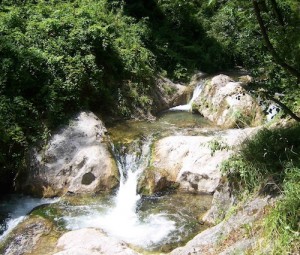 High above Amalfi, the Valle dei Mulini (Valley of the Mills) climbs into a magical and completely unexpected mountain landscape. Hiking up from the center of Amalfi, you soon pass the ruins of the town’s once thriving paper mills, which supplied fine quality paper all over southern Italy in the Middle Ages. Soon you enter another world, where pure, ice cold water from the high mountain source rushes through little pools. Then you’ll reach a point where the waterfalls bring to mind tropical rainforests rather than the rugged Amalfi Coast. At that moment the nearby sea and rocky beaches seem a world away.
High above Amalfi, the Valle dei Mulini (Valley of the Mills) climbs into a magical and completely unexpected mountain landscape. Hiking up from the center of Amalfi, you soon pass the ruins of the town’s once thriving paper mills, which supplied fine quality paper all over southern Italy in the Middle Ages. Soon you enter another world, where pure, ice cold water from the high mountain source rushes through little pools. Then you’ll reach a point where the waterfalls bring to mind tropical rainforests rather than the rugged Amalfi Coast. At that moment the nearby sea and rocky beaches seem a world away.
These two sides of the Amalfi Coast are also represented in the regional cuisine. In the villages along the sea, specialties are based on mare (sea) and the abundant seafood, while up the mountains you’re more likely to find dishes based on terra (earth). As you drive higher in the mountains to the villages of Scala, Ravello and Tramonti, you’ll find a landscape covered with chestnut trees and traditional dishes featuring salsicce and locally foraged funghi.
When people ask me for advice for visiting this beautiful part of Italy, I encourage them to try to experience both sides of the Amalfi Coast. Spend time swimming in the incredible waters and looking up at the towering mountain backdrop. But, if you have time, get up in the mountains, go hiking and experience the other side of the Amalfi Coast. For me, I feel as if I truly began to understand the Amalfi Coast’s beauty, culture and lifestyle when I began to explore the mountains and looked down on the tiny villages overlooking the Mediterranean Sea.
*
Laura Thayer is an art historian and freelance writer living on the Amalfi Coast in Italy. She is currently co-writing a novel set in Italy with her mother and writes about life on the Amalfi Coast at her website Ciao Amalfi. Photos © Laura Thayer, Ciao Amalfi!
*
Grazie mille Laura!
Tomorrow we’ll be headed to Florence, so be sure to come back!



